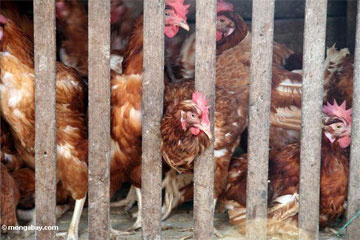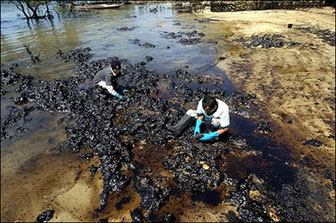Feathers, human hair used to fight oil spill in Philippines
Feathers, human hair used to fight oil spill in Philippines
mongabay.com
August 24, 2006
The Philippines has asked for hair clippings from salons and chicken feathers to help fight the country’s worst oil spill, according to a report from Reuters.
The oil spill occurred August 1 after Solar I, an oil tanker chartered by Petron Corp. sank in rough seas. About 1700 barrels (200,000 liters – 53,000 gallons) spilled initially, but because the tanker sank in deep water with as much as 15,300 barrels of bunker oil, more is expected to leak into the surrounding environment. According to Greenpeace, about 320 kilometers (200 miles) of coastline — including a coral reef located in a marine reserve and 27 coastal villages — have been affected by the spill.
To help fight the spill, the Philippine Coast Guard has appealed for hair and feathers, which have been shown to be highly effective at soaking up oil.
 Finally, a use for all the poultry slaughtered due to the bird flu scare? |
“We are appealing for the supply of indigenous absorbent materials like chicken feathers, human hair and rice straw,” Harold Jarder, head of the Coast Guard in Iloilo, a province north of Guimaras, is quoted by Reuters. Jarder said that San Miguel Corp., a giant food and beverage conglomerate, has agreed to donate one metric ton of chicken feathers a day from its nearby plants to combat the spill.
Alabama hairdresser developed technique
The hair-as-an-oil-absorbent concept was first popularized in 1989 when Phillip McCrory, a Madison, Alabama hairdresser, experimented with human hair as an oil sponge after watching volunteers on TV attempt to clean oil from the fur of sea otters following the Exxon Valdez oil spill. He filled an old pair nylon stockings with five pounds of hair and used them to soak up a mock oil spill he created in his son’s plastic pool. After seeing the results — the water was clear within minutes — McCrory approached NASA scientists at Marshall Space Flight Center in Huntsville, Alabama. The researchers soon began experimenting with hair. In one test, described by Ned Rozell of the Geophysical Institute at the University of Alaska Fairbanks, they filtered filled 40 gallons of water and 15 gallons of oil though nylon bags of hair to find the hair but the oil concentration to just 17 parts of oil per million parts of water or about two drops of oil for the 55-gallon drum.
At the time, McCrory estimated that 1.4 million pounds of hair could have soaked up the 11 million gallons of oil leaked by the Exxon Valdez. He has worked further with NASA to develop new hair-based ways to soak up oil.
The employment of hair and feathers as an oil “absorbent” in the Philippines marks a low-cost strategy for battling oil spills. Traditionally, booms, skimmers, and chemical dispersants are used methods to clean up ocean oil spills.
 Local residents, use rags and water to clean off some of the spilled oil that has collected at the rocks on the breakwater in Nueva Valencia town in Guimaras island after a tanker contracted by Petron, the Solar I, sank in rough seas on August 11 while carrying 500,000 gallons of oil. Environmental watchdog Greenpeace has begun assessing the damage caused by the Philippines’ worst ever oil spill amid reports that the captain of the ill-fated tanker was not properly trained to handle the ship. Photo and caption courtesy of AFP/Joel Nito. |
This article used information from Reuters (“Philippines asks for hair, feathers to soak oil spill”, August 24, 2006 by Leo Solinap) and the Geophysical Institute (“A Hairy Solution for Crude Oil Spills”, August 12, 1998 by Ned Rozell).